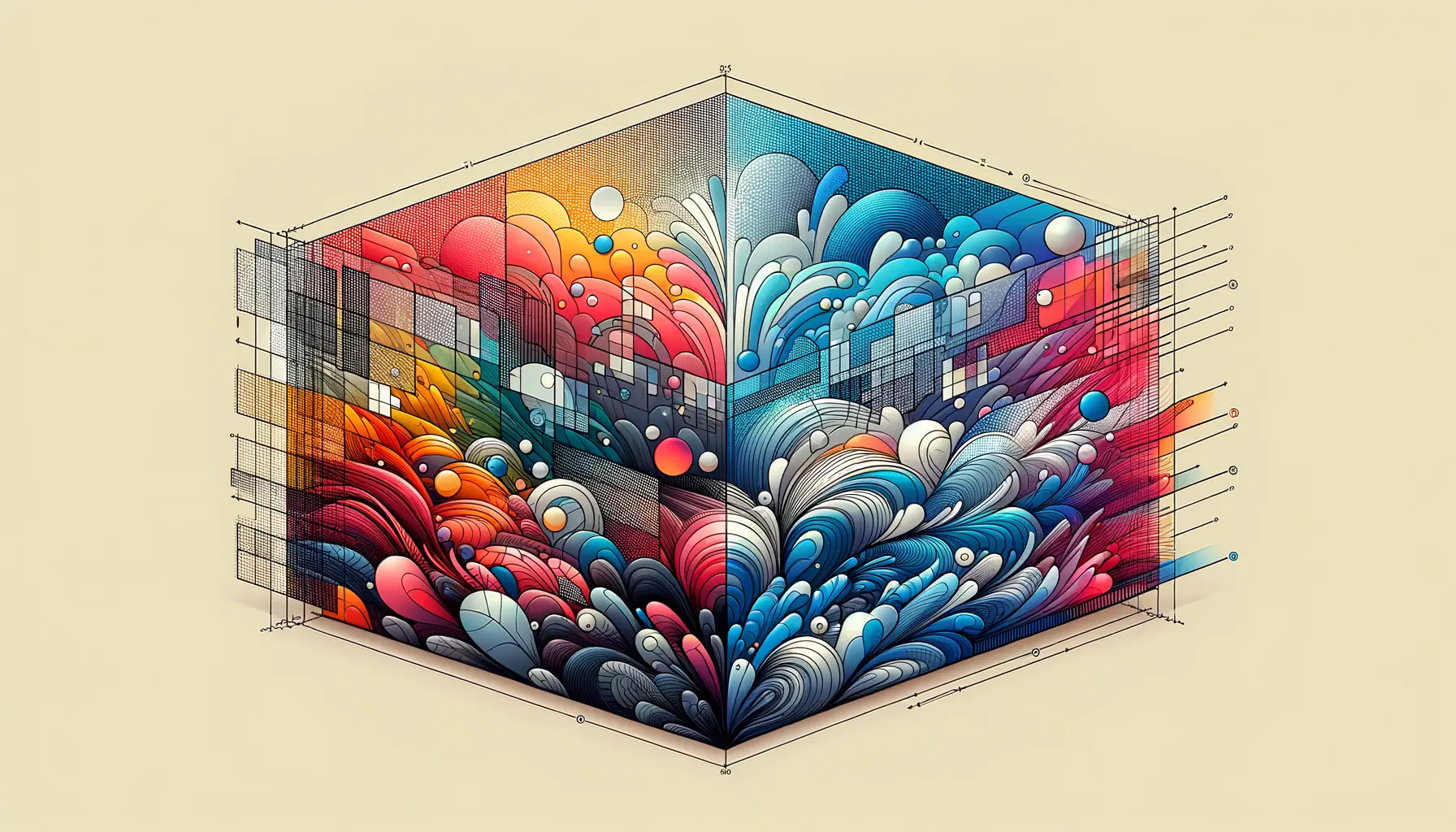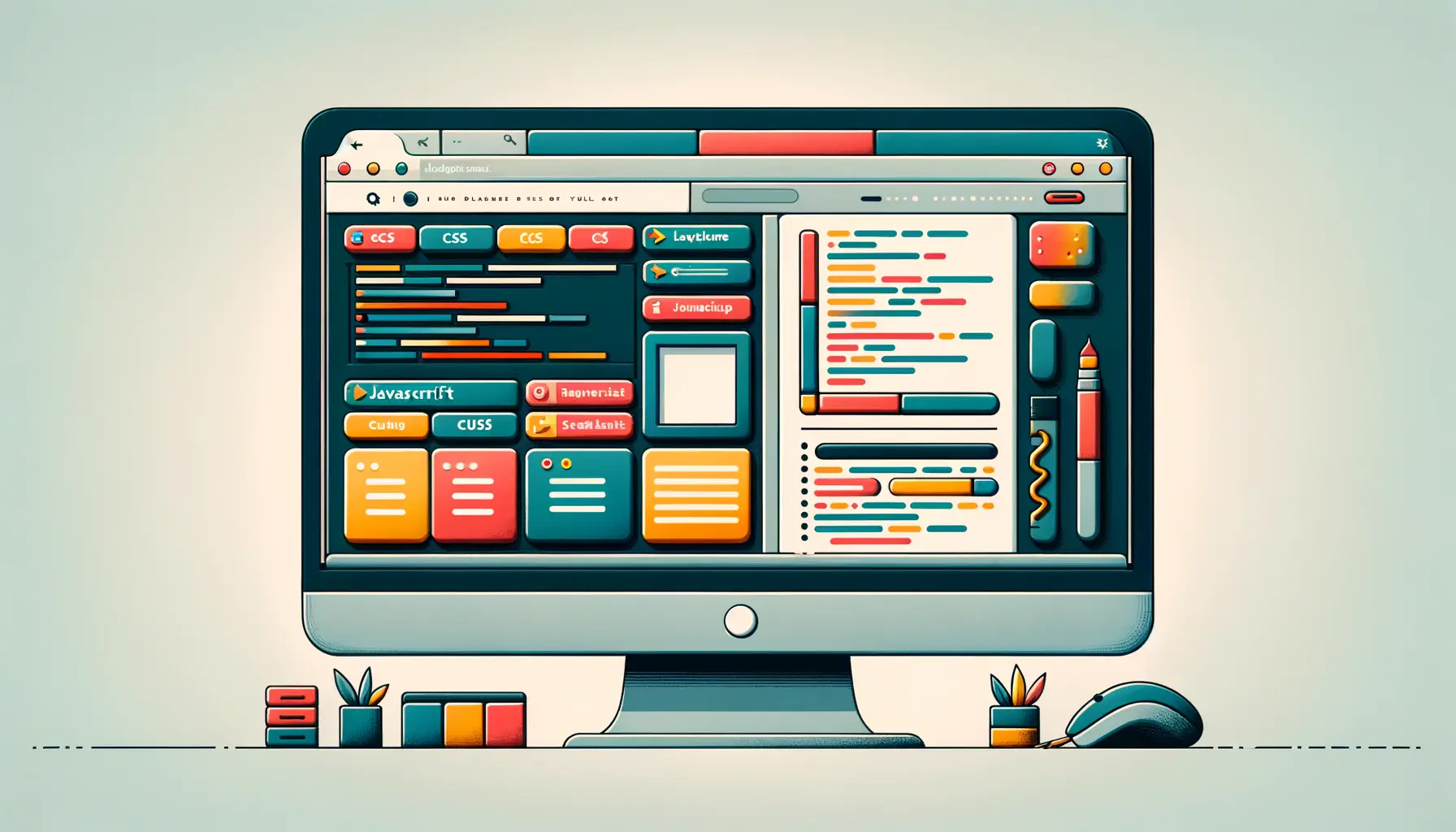The digital design landscape is ever-evolving, with CSS (Cascading Style Sheets) at the forefront of creating visually stunning and interactive web experiences.
Among the plethora of tools and techniques available to web designers, CSS blend modes stand out as a powerful feature that can significantly enhance the aesthetic appeal of a website.
Blend modes in CSS offer a unique way to manipulate the color and texture of elements, allowing designers to achieve effects that were once only possible in graphic design software.
Understanding the concept of blend modes is crucial for designers looking to push the boundaries of web design.
Essentially, blend modes determine how an element’s colors blend with the colors of elements behind it, creating various visual effects by mixing pixel values.
This capability opens up a realm of creative possibilities, from subtle texturing to dramatic color overlays, all achieved directly within the stylesheet without the need for external graphics editing tools.
- The Fundamentals of CSS Blend Modes
- Exploring Advanced Techniques with CSS Blend Modes
- Incorporating Blend Modes into Responsive Design
- Best Practices for Using CSS Blend Modes
- Exploring Creative Examples of CSS Blend Modes
- Challenges and Solutions in Implementing CSS Blend Modes
- Future Trends in CSS Blend Modes
- Embracing the Future of Web Design with CSS Blend Modes
- CSS Blend Modes: Your Questions Answered
The Fundamentals of CSS Blend Modes
At its core, CSS blend modes are about mixing the visual content of two elements to produce a third, visually compelling result.
This blending is achieved by applying mathematical operations to the color values of the pixels involved.
The beauty of using blend modes lies in their simplicity and the depth of creativity they unlock.
Designers can layer images, text, and backgrounds in ways that enhance the user’s visual experience and convey messages more effectively.
There are several blend modes available in CSS, each offering a different way of combining elements.
These include modes like ‘multiply’, which darkens colors by multiplying pixel values, and ‘screen’, which does the opposite by lightening them.
Other modes like ‘overlay’, ‘darken’, ‘lighten’, and ‘color-dodge’ provide additional control over how elements interact visually, enabling designers to achieve the perfect balance and contrast in their compositions.
Practical Applications of Blend Modes
One of the most common applications of CSS blend modes is in creating dynamic backgrounds that interact with foreground content.
By blending a background image with a color or another image, designers can create textured, layered effects that add depth to the design.
This technique can be particularly effective in hero sections, where a striking visual impact is essential for capturing user attention.
Another practical use of blend modes is in enhancing typography.
By blending text with background images, designers can create visually interesting text effects that go beyond traditional color and font styling.
This can be especially useful for headlines and call-to-action buttons, where the goal is to make the text stand out and grab the user’s attention.
Exploring the creative potential of CSS blend modes can significantly elevate the quality of web design projects, making them more engaging and visually appealing.
Exploring Advanced Techniques with CSS Blend Modes
As web designers become more familiar with the basics of CSS blend modes, the next step is to delve into more advanced techniques that can further enhance the visual appeal of their projects.
These techniques not only add depth and texture to the design but also create a more engaging user experience.
By mastering advanced blend mode applications, designers can set their work apart in the competitive digital landscape.
Advanced blend mode techniques involve a combination of multiple blend modes, layering, and interaction with user actions.
These methods require a deeper understanding of how blend modes work and how they can be manipulated to achieve specific effects.
Layering and Multiple Blend Modes
- Creating Depth: By stacking multiple layers with different blend modes, designers can create a sense of depth in their designs. This technique is particularly effective for backgrounds, where layered textures can produce a rich, immersive experience.
- Complex Overlays: Combining several blend modes can result in complex overlays that add visual interest to images and text. For example, using ‘multiply’ for darkening and ‘screen’ for lightening in different areas of an image can highlight specific elements.
Interactive Elements with Blend Modes
- Dynamic Hover Effects: Blend modes can be used to create dynamic hover effects for buttons and links. Changing the blend mode on hover can transform the visual appearance of an element, encouraging user interaction.
- Animated Transitions: Incorporating blend modes in CSS animations and transitions can produce unique visual effects as elements enter or leave the viewport. This technique can be used to draw attention to specific sections of a webpage.
Enhancing Visual Storytelling
- Thematic Consistency: Blend modes can be employed to maintain thematic consistency across a website. By adjusting the blend modes of images and backgrounds to match the site’s color scheme, designers can create a cohesive visual narrative.
- Emphasizing Branding: Blend modes offer an opportunity to reinforce branding elements subtly throughout a website. Blending logos or brand motifs with background elements can embed brand identity more deeply into the design.
Advanced CSS blend mode techniques offer a toolkit for creating deeply engaging and visually rich web experiences. By experimenting with layering, interactivity, and storytelling elements, designers can unlock new dimensions of creativity in their projects.
Incorporating Blend Modes into Responsive Design
As the web continues to evolve, the importance of responsive design cannot be overstated.
A website must look and function flawlessly across a myriad of devices, from desktops to smartphones.
CSS blend modes play a crucial role in ensuring that visual elements adapt seamlessly to different screen sizes and resolutions, maintaining the integrity and impact of the design across all platforms.
Integrating blend modes into a responsive design framework involves strategic planning and testing.
Designers must consider how blend effects will scale, how they interact with responsive images, and how they contribute to the overall user experience on smaller screens.
Adapting Blend Modes for Mobile Devices
- Optimizing Performance: Blend modes can be resource-intensive, especially on mobile devices. It’s essential to optimize images and limit the use of complex blend modes to ensure smooth performance.
- Touch Interactions: Considering how blend modes change with touch interactions, such as taps and swipes, can add an interactive layer to the mobile experience.
Testing Across Browsers and Devices
- Cross-Browser Compatibility: Testing how blend modes render across different browsers is crucial, as support can vary. Designers should use fallbacks for browsers that do not fully support blend modes.
- Device-Specific Adjustments: Some blend modes may appear differently on various devices due to screen technology and resolution. Adjustments may be necessary to maintain visual consistency.
Enhancing Usability with Blend Modes
- Improving Readability: On smaller screens, ensuring text readability over blended backgrounds is vital. Designers can use blend modes to adjust background images or colors to enhance text contrast.
- Flexible Backgrounds: Using blend modes for background images can create flexible designs that adapt more gracefully to different screen sizes, contributing to a more cohesive responsive design.
While blend modes offer a powerful tool for creative design, their integration into responsive design requires careful consideration of performance, compatibility, and usability to ensure a positive user experience across all devices.
Best Practices for Using CSS Blend Modes
While CSS blend modes open up a world of creative possibilities, their effective use requires adherence to certain best practices.
These guidelines ensure that the application of blend modes enhances the design without compromising performance or accessibility.
By following these best practices, designers can leverage blend modes to create visually stunning and user-friendly web experiences.
Understanding the nuances of blend modes and their impact on web design is crucial.
This knowledge allows designers to make informed decisions, ensuring that blend modes serve the design’s goals and the users’ needs.
Optimizing Performance
- Limit Use on Complex Pages: Blend modes can be performance-intensive. On pages with heavy content or complex interactions, use blend modes sparingly to avoid slowing down the page.
- Prefer CSS Over Images: Whenever possible, use CSS properties (like gradients) with blend modes instead of blending large images. CSS is generally more performance-efficient than raster graphics.
Ensuring Accessibility
- Contrast and Readability: Always ensure that text remains readable when using blend modes for background effects. High contrast between text and its background is crucial for accessibility.
- Supportive Design: Use blend modes to support the content’s message rather than distract from it. The primary goal should always be to enhance the user’s understanding and experience.
Maintaining Design Consistency
- Consistent Visual Language: Blend modes should complement the site’s overall design language. Consistency in how blend modes are applied helps maintain a cohesive look and feel.
- Theme and Mood: The choice of blend mode should align with the website’s theme and mood. For instance, a ‘multiply’ blend mode might suit a dark, moody site, while ‘screen’ could enhance a lighter, airier design.
Testing and Cross-Browser Compatibility
- Extensive Testing: Test designs with blend modes across various devices and browsers to ensure consistent rendering. Pay special attention to older browsers or those with known compatibility issues.
- Fallback Strategies: Implement fallback strategies for browsers that do not support specific blend modes. This might involve using alternative CSS techniques or even omitting the effect where necessary.
Properly utilized, CSS blend modes are a powerful tool in the web designer’s arsenal, capable of creating engaging, dynamic visuals. However, their use should always be balanced with considerations for performance, accessibility, and overall design coherence.
Exploring Creative Examples of CSS Blend Modes
CSS blend modes have been embraced by web designers and developers for their ability to add depth, texture, and visual interest to web pages.
From subtle text effects to dramatic background blends, the creative applications of blend modes are virtually limitless.
By examining real-world examples, we can gain insights into how blend modes can transform the visual appeal of a website and enhance user engagement.
These examples not only showcase the versatility of blend modes but also serve as inspiration for incorporating similar effects into your own web design projects.
Let’s explore some innovative ways designers are using blend modes to create stunning web experiences.
Dynamic Backgrounds and Overlays
- Interactive Hero Sections: Blend modes are often used in hero sections to blend background images with dynamic colors or gradients, creating an engaging first impression as users enter the site.
- Hover Effect Galleries: Image galleries can be enhanced with blend modes, where hovering over an image changes its blend mode, adding an interactive element to the browsing experience.
Text Effects and Typography
- Textured Typography: Applying blend modes to text can give it a textured or patterned appearance, making headlines and call-to-action buttons stand out on the page.
- Blended Text Overlays: Text overlaid on images can be blended using modes like ‘overlay’ or ‘screen’ to ensure readability while maintaining the visual integrity of the underlying image.
Visual Storytelling and Branding
- Thematic Consistency: Blend modes can be used to adjust images and elements to fit a site’s color scheme or theme, ensuring visual consistency across the website.
- Branding Elements: Logos and branding elements can be subtly integrated into backgrounds or images using blend modes, reinforcing brand identity without overwhelming the content.
The creative application of CSS blend modes in web design not only enhances the aesthetic appeal of a website but also engages users in a more interactive and immersive experience. By exploring and experimenting with blend modes, designers can unlock new possibilities for visual storytelling and design innovation.
Challenges and Solutions in Implementing CSS Blend Modes
While CSS blend modes offer a plethora of creative possibilities, their implementation is not without challenges.
These challenges range from performance issues to cross-browser compatibility concerns.
However, with every challenge comes a solution, and understanding these can help designers and developers make the most out of blend modes in their projects.
Addressing these challenges effectively ensures that the use of blend modes enhances rather than hinders the user experience.
Let’s delve into some common obstacles encountered when working with CSS blend modes and explore practical solutions to overcome them.
Performance Considerations
- Issue: Blend modes can be performance-intensive, especially when applied to large areas or complex animations, potentially leading to sluggish page loads and interactions.
- Solution: Optimize images and limit the use of blend modes on critical performance areas. Consider using blend modes on user interaction rather than as a static effect to reduce initial page load impact.
Cross-Browser Compatibility
- Issue: Not all browsers support CSS blend modes equally, leading to inconsistent visual experiences across different user environments.
- Solution: Use feature detection tools like Modernizr to detect support for blend modes and provide fallback styles for browsers that lack support. This ensures a consistent look and feel across all platforms.
Accessibility and Readability
- Issue: Incorrect use of blend modes can lead to text readability issues, especially when blending text with complex backgrounds.
- Solution: Always test the readability of text with various blend modes and backgrounds. Use high-contrast color combinations and consider adding background layers or shadows to text to improve legibility.
Design Consistency
- Issue: Maintaining a consistent design aesthetic can be challenging when using blend modes, as their effects can vary dramatically with different content and backgrounds.
- Solution: Develop a cohesive design system that includes guidelines for using blend modes. This system should specify when and how to use blend modes to ensure they complement the overall design.
While CSS blend modes are a powerful tool for enhancing web design, it’s essential to approach their use thoughtfully, considering performance, compatibility, and user experience to ensure they add value to the design rather than detracting from it.
Future Trends in CSS Blend Modes
The evolution of web technologies is relentless, with CSS blend modes representing just one of the many advancements that have transformed web design in recent years.
As browsers become more powerful and web standards continue to evolve, the future of CSS blend modes looks promising.
This progression will likely introduce new capabilities, enhance performance, and expand creative possibilities for designers and developers alike.
Anticipating future trends in CSS blend modes not only prepares us for what’s coming but also inspires us to think creatively about how we can leverage these advancements in our current projects.
Let’s explore some potential future directions for CSS blend modes and their impact on web design.
Increased Browser Support and Performance
- Enhanced Compatibility: As web standards evolve, we can expect broader support for CSS blend modes across all major browsers, reducing the need for workarounds and fallbacks.
- Performance Optimizations: Future browser versions may offer optimized rendering of blend modes, minimizing their performance impact and enabling more complex effects without compromising page speed.
New Blend Modes and Functions
- Expansion of Blend Modes: The CSS specification may introduce new blend modes, offering even more creative control over how elements blend together on the web.
- Advanced Blending Functions: We might see the introduction of more sophisticated blending functions, allowing for dynamic blending based on user interactions or other criteria.
Integration with Other CSS Features
- Seamless Interaction with CSS Variables: Enhanced integration between CSS blend modes and CSS variables could allow for more dynamic and customizable blending effects that can be easily adjusted across a site.
- Combination with CSS Grid and Flexbox: As CSS layout mechanisms like Grid and Flexbox continue to mature, we’ll likely see innovative ways to combine these layouts with blend modes for even more flexible and creative designs.
Enhanced Creative Possibilities
- Interactive Storytelling: With advancements in blend modes, designers will have new tools for creating immersive, interactive storytelling experiences on the web.
- Dynamic Visual Effects: Future developments in blend modes could enable dynamic visual effects that respond to user inputs, environmental conditions, or other real-time data.
As we look to the future, the potential for CSS blend modes in web design is vast and exciting. By staying informed about advancements in web technologies and experimenting with current capabilities, designers and developers can continue to push the boundaries of what’s possible on the web.
Embracing the Future of Web Design with CSS Blend Modes
The exploration of CSS blend modes in this article underscores their transformative potential in web design.
As we’ve navigated through the fundamentals, advanced techniques, and practical applications, it’s clear that blend modes are more than just a stylistic tool—they are a gateway to innovative design solutions that enhance user engagement and visual communication.
The journey through CSS blend modes reveals a future where creativity and technology converge to create immersive web experiences.
The Creative and Technical Synergy
CSS blend modes represent a unique intersection of creative vision and technical prowess.
They empower designers to experiment with visual aesthetics in ways that were previously constrained to graphic design software.
This synergy between creativity and technology not only elevates the design process but also enriches the user experience, making web pages not just a medium of information, but a canvas for artistic expression.
Challenges, Solutions, and Opportunities
- Performance and Compatibility: The challenges of performance and cross-browser compatibility highlight the importance of thoughtful implementation. Optimizing images, leveraging feature detection, and providing fallbacks ensure that blend modes enhance rather than detract from the user experience.
- Accessibility and Usability: Ensuring that blend modes do not compromise accessibility and readability is paramount. This commitment to usability underscores the designer’s role in creating inclusive and engaging digital spaces.
- Innovation and Experimentation: The potential for new blend modes and functions points to an exciting horizon of design possibilities. As web standards evolve, so too will the tools at our disposal, encouraging continuous innovation and experimentation.
Looking Ahead
The future of CSS blend modes in web design is bright, with advancements in browser support, performance optimizations, and the introduction of new blend modes on the horizon.
These developments promise to further unlock creative potential, enabling designers to craft experiences that are not only visually captivating but also deeply resonant with users.
In conclusion, CSS blend modes are a testament to the dynamic nature of web design, a field that continually evolves to offer more expressive and engaging ways to tell stories and connect with users.
By embracing CSS blend modes, designers and developers can push the boundaries of what’s possible, crafting web experiences that are not just seen but felt.
As we look to the future, the role of blend modes in shaping the visual language of the web is undeniable, offering a blend of artistry and innovation that will continue to inspire and captivate.
Quality web design is key for a great website! Check out our service page to partner with an expert web design agency.
CSS Blend Modes: Your Questions Answered
Delving into CSS blend modes raises numerous questions, especially as designers and developers seek to leverage this powerful feature for creative design. Here are answers to some frequently asked questions that might illuminate the path for those exploring the possibilities of blend modes in CSS.
CSS blend modes are a feature that determines how an element’s content blends with the content behind it, creating various visual effects.
Use the ‘mix-blend-mode’ or ‘background-blend-mode’ properties in your CSS to apply blend modes to elements.
Yes, extensive use of blend modes, especially on large elements, can impact performance. Optimize usage for best results.
Most modern browsers support CSS blend modes, but it’s wise to check compatibility and provide fallbacks for older versions.
Common modes include ‘multiply’, ‘screen’, ‘overlay’, ‘darken’, ‘lighten’, and ‘color-dodge’ among others.
Blend modes can add depth, texture, and visual interest, enhancing the overall aesthetic and user engagement.
Yes, blend modes can create unique text effects, improving readability and visual appeal against varied backgrounds.
As browser support expands and performance improves, expect more creative and dynamic uses of blend modes in design.











